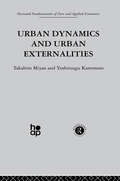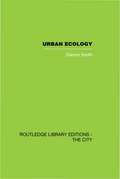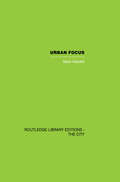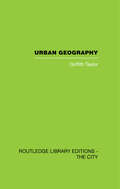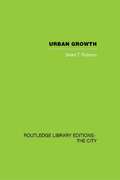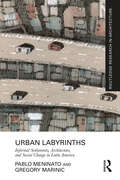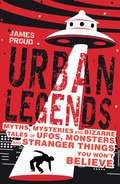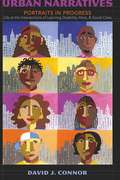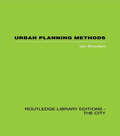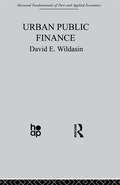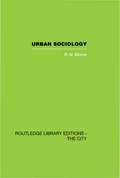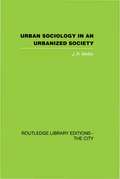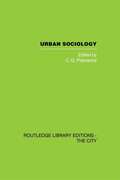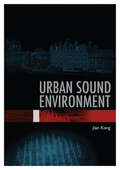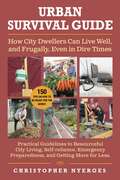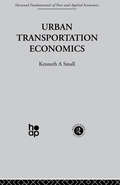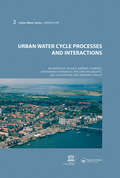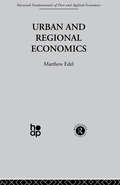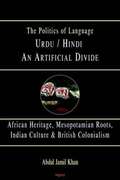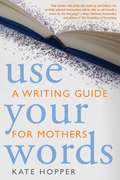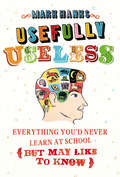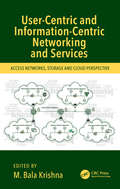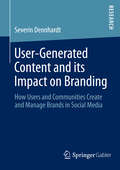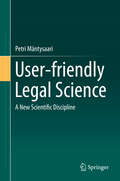- Table View
- List View
Urban Dynamics and Urban Externalities
by Y. Kanemoto T. MiyaoThis title combines reviews of two of the most important branches of urban economics: dynamics and externalities.
Urban Ecology
by Dianne SmithThere are many micro-habitats in built up areas, often subject to strong environmental pressures such as atmospheric and water pollution, frequent disturbance, trampling, nutrient or water scarcity, etc. In Urban Ecology Dianne Smith uses such features as footpaths, walls, gravestones, gardens, compost heaps and derelict land to investigate the effects of these pressures and to demonstrate other ecological properties of oftern isolated habitats. This book was first published in 1984.
Urban Focus
by Mark HewlettThis project is aimed the 16+ age range inside or outside any kind of educational institution. It is for courses concerned with general education - either in general studies programmes or as aspects of specialist teaching. Narrative has been kept to a minimum. Instead, the books are more a collection of different items of teaching and learning materials: for example, the collection of key concepts, and the list of key questions connected withe the study. The books are compact in content and flexible in use. This book was first published in 1974.
Urban Geography: A Study of Site, Evolution, Patern and Classification in Villages, Towns and Cities
by Griffith TaylorThis book is divided into three parts. The first deals with typical settelements in each of the seven continents, the early stages of settlements, land surveys and general phases of town evolution. The second part discusses changes in site and patter, from Neolithic to modern times. The third part specializes in topographic and functional controls in modern towns. Chapters on Planning, Regional Surveys and Classification of towns close the book. There are about 300 specially drawn plans and diagrams of towns - which should appeal to the sociologist and town planner as well as to every serious student of geography. This book was first published in 1949.
Urban Growth: An Approach
by Brian T. RobsonDo large cities grow more or less rapidly than small ones? Why should the relationship between city size and population growth vary so much from one period to another? This book studies the process of population growth in a national set of cities, relating its findings to the theoretical concepts of urban geography. To test his ideas, the author studies the growth of cities in England and Wales between 1801 and 1911. His explanations draw strongly on the connection between growth and the adoption of innovations. He develops a model of innovation diffusions in a set of cities and, in support of this model, looks at the way in which three particular innovations - the telephone, building societies and gaslighting - spread amongst English towns in the nineteenth century. This book was first published in 1973.
Urban Labyrinths: Informal Settlements, Architecture, and Social Change in Latin America (Routledge Research in Architecture)
by Gregory Marinic Pablo MeninatoUrban Labyrinths: Informal Settlements, Architecture, and Social Change in Latin America examines intervention initiatives in informal settlements in Latin American cities as social, spatial, architectural, and cultural processes. From the mid-20th century to the present, Latin America and other regions in the Global South have experienced a remarkable demographic trend, with millions of people moving from rural areas to cities in search of work, healthcare, and education. Without other options, these migrants have created self-built settlements mostly located on the periphery of large metropolitan areas. While the initial reaction of governments was to eliminate these communities, since the 1990s, several Latin American cities began to advance new urban intervention approaches for improving quality of life. This book examines informal settlement interventions in five Latin American cities: Rio de Janeiro, Medellín, São Paulo, Buenos Aires, and Tijuana. It explores the Favela-Bairro Program in Rio de Janeiro during the 1990s which sought to improve living conditions and infrastructure in favelas. It investigates projects propelled by Social Urbanism in Medellín at the beginning of the 2000s, aimed at revitalizing marginalized areas by creating a public transportation network, constructing civic buildings, and creating public spaces. Furthermore, the book examines the long-term initiatives led by SEHAB in São Paulo, which simultaneously addresses favela upgrading works, water pollution remediation strategies, and environmental stewardship. It discusses current intervention initiatives being developed in informal settlements in Buenos Aires and Tijuana, exploring the urban design strategies that address complex challenges faced by these communities. Taken together, the Latin American architects, planners, landscape architects, researchers, and stakeholders involved in these projects confirm that urbanism, architecture, and landscape design can produce positive urban and social transformations for the most underprivileged.This book will be of interest to students, researchers, and professionals in planning, urbanism, architecture, urban design, landscape architecture, urban geography, public policy, as well as other spatial design disciplines.
Urban Legends: Bizarre Tales You Won't Believe
by ProudExciting Legendary Tales That Will Captivate Any Reader!Did you hear about the kids who found a Ferrari buried in their garden? What about the man who sued Satan? Or the woman who woke up in the middle of her funeral? Do you know the legend of the bunny man? There are some stories that people will claim are true without a doubt, no matter the circumstance. This collection showcases the best of these fascinating and often creepy tales. The tales featured within fall under the following categories: Supernatural Pop Culture Medical Historical Mystery Death Crimes The Government Animals Tragedies And Many Other Fascinating Topics! Whether you believe these urban myths or not, they have the power to unnerve and enthrall us all. This incredible compilation of captivating stories will keep any reader on the edge of their seat.
Urban Narratives: Portraits in Progress, Life at the Intersections of Learning Disability, Race, and Social Class
by David J. ConnorThis book focuses on the experiences of the author as a teacher in an urban public school special education programs, where students are labeled learning disabled (LD), Black or Latino(a), and working-class or poor.
Urban Planning Methods: Research and Policy Analysis
by Ian BrackenIn order to develop and exercise their skills urban planners need to draw upon a wide variety of methods relating to plan and policy making, urban research and policy analysis. More than ever, planners need to be able to adapt their methods to contemporary needs and circumstances. This introductory textbook focuses on the need to combine traditional research methods with policy analysis in order to understand the true nature of urban planning processes. It describes both planning methods and their underlying concepts and principles, illustrating applications by reference to the daily activities of planning, including the assessment of needs and preferences of the population, the generation and implementation of plans and policies, and the need to take decisions related to the allocation of land, population change, employment, housing and retailing. Ian Bracken also provides a comprehensive guide to the more specialized research literature and case studies of contemporary urban planning practice. This book was first published in 1981.
Urban Public Finance
by D. WildasinConsiders such issues as the effect of local government policies on migration, the optimal size of cities, tax and expenditure capitalization, the economics of intergovernmental transfers, tax exporting and tax competition.
Urban Sociology
by R.N. MorrisThis book offers a coherant theoretical introduction to urban sociology. Based on the urban theory of Louis Wirth, it systematically examines Wirth's principal ideas in the contexts of pre-industrial cities, industrial cities and bureaucracies. Morris discusses conditions for the emergence of cities and for industrialization. He relates organisational and ecological accounts of the city and considers the contributions of each. Bureaucracy appears as a peculiarly urban form of organisation: its ecological and social characteristics are examined in an original manner and with considerable insight so as to illustrate and modify the propositions derived from Wirth's theory. The book concludes with a comprehensive evaluation of Wirth and his critics. This book was first published in 1968.
Urban Sociology and Urbanized Society (International Library Of Sociology)
by J.R. MellorFocusing on urban sociology as practised in Britain, the author argues that it is a key element in the response of the 'intellectual proletariat' to urbanization and the calls on it by the State to control the ensuing way of life. The themes of urban sociology have been the concerns of the Welfare State and, despite radical inputs, the discipline has remained tied up with the assumptions and methodological precepts of liberalism. The author's contention is that urbanization should be analysed in the framework of the political economy of regional development. This book was first published in 1977.
Urban Sociology: Critical Essays
by C. G. PickvanceThis book applies the historical materialist, or Marxist view of urban sociology and collates some fundamental sources of this perspective available. This book was first published in 1976.
Urban Sound Environment
by Jian KangOver the past two decades there have been many major new developments in the field of urban sound environment. Jian Kang introduces and examines these key developments, including:the development of prediction methods for urban sound propagationestablishment and application of noise-mapping softwarenew noise control measures and design methods.Also
Urban Survival Guide: How City Dwellers Can Live Well, and Frugally, Even in Dire Times
by Christopher NyergesPractical Guidelines to Resourceful City Living, Self-reliance, Emergency Preparedness, and Getting More for Less A survival guidebook that reflects the world in which we now find ourselves. The post 9/11 world seems a bit more hostile, as terrorist threats and attacks are no longer a surprise. The Great Tsunami of Christmas 2004 showed us that quick extinctions (like Noah&’s flood) can and do happen without apparent warning. Hurricanes Katrina and Sandy not only told us that it can happen to us, but that it is foolhardy to make no preparations and pretend that the government will take care of you in the post-disaster landscape. The price of gold id rising again. War, rumors of war, famines, political instability, economic instability, global pandemics – all these and more are causes of concern to the average family. Economic survival is also addresses, since this is such a fundamental building block of everything else in modern society. Money cannot be ignored.
Urban Transportation Economics
by K. SmallThis title provides a comprehensive review of the economics of urban transportation.
Urban Water Cycle Processes and Interactions: Urban Water Series - UNESCO-IHP (Urban Water Series)
by Jiri MarsalekUrban Water Cycle Processes and Interactions represents the fruit of a project by UNESCO's International Hydrological Programme on this topic. The volume introduces the urban water cycle concept and the need for integrated or total management. It then explores in detail the manifold hydrological components of the cycle, the diverse elements of urban infrastructure and water services, and the various effects of urbanization on the environment - from the atmosphere and surface waters to wetlands, soils and groundwater, as well as biodiversity. A concluding series of recommendations for effective urban water management summarize the important findings set forth here.
Urban and Regional Economics: Marxist Perspectives (Fundamentals Of Pure And Applied Economics Ser.)
by M. EdelThis title discusses the treatment of urban and regional issues by Marx, Engels and other early Marxists, and examines recent controversies in these areas.
Urdu/Hindi: Evolution from African Genes, Mesopotamian Roots, and Indian Culture
by Abdul Jamil KhanThe lingua franca of the Indo-Pakistani people is one language, claims Khan, called Hindi when written in Nagari and Urdu when written in Arabic. He says it is not descended from Sanskrit, as conventionally believed, but is 10-12,000 years old and was influenced early by the Austric-Munda and Dravidian language families. Leaving aside any religious argument, he buttresses his theory with evidence from evolution, Sumerian, and the European concept of mythical races linked to linguistic families. His experience teaching pediatrics and infant speech development led him to the study of linguistics and history. Annotation ©2006 Book News, Inc. , Portland, OR (booknews. com)
Use Your Words
by Hope Edelman Kate HopperUSE YOUR WORDS introduces the art of creative nonfiction to women who want to give written expression to their lives as mothers. Written by award-winning teacher and writer, Kate Hopper, this book will help women find the heart of their writing, learn to use motherhood as a lens through which to write the world, and turn their motherhood stories into art. Each chapter of USE YOUR WORDS focuses on an element of craft and contains a lecture, a published essay, and writing exercises that will serve as jumping-off points for the readers' own writing. Chapter topics include: the importance of using concrete details, an overview of creative nonfiction as a genre, character development, voice, humor, tense and writing the "hard stuff," reflection and back-story, structure, revision, and publishing. The content of each lecture is aligned with the essay/poem in that chapter to help readers more easily grasp the elements of craft being discussed. Together the chapters provide a unique opportunity for mother writers to learn and grow as writers.USE YOUR WORDS takes the approach that creative writing can be taught, and this underscores each chapter. When students learn to read like writers, to notice how a piece is put together, and to question the choices a writer makes, they begin to think like writers. When they learn to ground their writing in concrete, sensory details and begin to understand how to create believable characters and realistic dialogue, their own writing improves. USE YOUR WORDS reflects Kate's style as a teacher, guiding the reader in a straightforward, nurturing, and passionate voice. As one student noted in a class evaluation: "Kate is a born writer and teacher, and her enthusiasm for essays about motherhood and for teaching the nuts and bolts of writing so that ordinary mothers have the tools to write their stories is a gift to the world. She is raising the value of motherhood in our society as she helps mothers build their confidence and strengthen their game as writers."
Use Your Words: A Writing Guide for Mothers
by Kate HopperUSE YOUR WORDS introduces the art of creative nonfiction to women who want to give written expression to their lives as mothers. Written by award-winning teacher and writer, Kate Hopper, this book will help women find the heart of their writing, learn to use motherhood as a lens through which to write the world, and turn their motherhood stories into art. Each chapter of USE YOUR WORDS focuses on an element of craft and contains a lecture, a published essay, and writing exercises that will serve as jumping-off points for the readers' own writing. Chapter topics include: the importance of using concrete details, an overview of creative nonfiction as a genre, character development, voice, humor, tense and writing the "hard stuff," reflection and back-story, structure, revision, and publishing. The content of each lecture is aligned with the essay/poem in that chapter to help readers more easily grasp the elements of craft being discussed. Together the chapters provide a unique opportunity for mother writers to learn and grow as writers. USE YOUR WORDS takes the approach that creative writing can be taught, and this underscores each chapter. When students learn to read like writers, to notice how a piece is put together, and to question the choices a writer makes, they begin to think like writers. When they learn to ground their writing in concrete, sensory details and begin to understand how to create believable characters and realistic dialogue, their own writing improves. USE YOUR WORDS reflects Kate's style as a teacher, guiding the reader in a straightforward, nurturing, and passionate voice. As one student noted in a class evaluation: "Kate is a born writer and teacher, and her enthusiasm for essays about motherhood and for teaching the nuts and bolts of writing so that ordinary mothers have the tools to write their stories is a gift to the world. She is raising the value of motherhood in our society as she helps mothers build their confidence and strengthen their game as writers."
Usefully Useless: Everything you'd Never Learn at School (But May Like to Know)
by Mark HanksUsefully Useless is a gloriously diverse volume dedicated to the most engrossing trivia in the world. Guaranteed to excite the curiosity and amuse, its pages are filled with the sort of remarkable information you would never learn, but will be overjoyed to discover. Each fact is irresistibly fun and fascinating - the essence of anecdote and dinner-party conversation that is essential in the adult world - and, above all, usefully useless. Guaranteed to improve your mind, Usefully Useless contains a wealth of miscellany on a vast range of topics, including Literature, Geography, Food, Science, the Natural World, Sport and Politics - from the export of frogs' legs to the longest Monopoly game completed in the bath. Usefully Useless provides answers to such eternal questions as:What was Margaret Thatcher's favourite sitcom?Which British league football team's name has no letters that one could colour in with a pen?How many calories do you consume when you lick a stamp?What was the original colour of Coca-Cola?Which key do toilets flush in?Find out these answers and many, many more in Usefully Useless, the essential guide to the facts you never thought you'd need to know.
User-Centric and Information-Centric Networking and Services: Access Networks, Storage and Cloud Perspective
by M. Bala KrishnaUser-Centric Networks (UCN) and Information-Centric Networks (ICN) are new communication paradigms to increase the efficiency of content delivery and also content availability. In this new concept, the network infrastructure actively contributes to content caching and distribution. This book presents the basic concepts of UCN and ICN, describes the main architecture proposals for these networks, and discusses the main challenges to their development. The book also looks at the current challenges for this concept, including naming, routing and caching on the network-core elements, several aspects of content security, user privacy, and practical issues in implementing UCN and ICN.
User-Generated Content and its Impact on Branding
by Severin DennhardtThe emergence of social media as one of the driving forces of consumers' online experiences today also challenges our current understanding on marketing and brand management. The effects of brands' social media involvement are to this day uncertain. Severin Dennhardt shows that social media and user-generated brands do have a strong influence on brands. Four independent studies demonstrate that first, successful brands can be created in virtual worlds, second, user-generated content drives the creation of unique brands, third social media strongly influences the social value perception of brands, and fourth, social media impacts consumers' purchase decision process.
User-friendly Legal Science
by Petri MäntysaariThis book defines the characteristics of a new discipline that is both legal and scientific: user-friendly legal science.Focusing on how legal tools and practices can be used to achieve objectives in different contexts, it offers an alternative to doctrinal research, law-and-something disciplines, and the traditional interdisciplinary approach.The book not only defines the new discipline’s research approach, point of view, theory-building, and research methods, it also shows how it relates to other scientific disciplines and how existing doctrinal legal disciplines can be upgraded into scientific disciplines.
